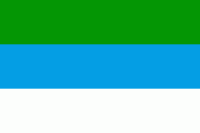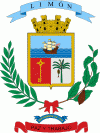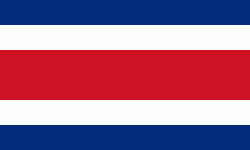Limón Province (Provincia de Limón)
 |
 |
The majority of its territory is situated in the country's Caribbean lowlands, though the southwestern portion houses part of an extensive mountain range known as the Cordillera de Talamanca. The province shares its northern border with Nicaragua via the Río San Juan, its western borders with the provinces of Heredia, Cartago, and Puntarenas, and its southern border with Panama via the Río Sixaola. Within the province there are six cantons, or counties, which include Pococí, Guácimo, Siquirres, Matina, Limón, and Talamanca. Each cantón has several local districts.
Limón is one of the most culturally diverse of Costa Rica's provinces, housing a significant Afro-Caribbean and indigenous population. Several languages (Spanish, Limón Creole) are spoken, and due mainly to its cultural ties to the Caribbean islands, dishes like rice and beans are ubiquitous throughout the province, along with reggae, calypso, and soca music (see "Demographics").
The capital is Puerto Limón, and other important cities include Siquirres, Puerto Viejo de Talamanca, and Guápiles.
Locals refer to themselves as limonenses.
Columbus was the first European to visit Limón during his fourth and final voyage to the Americas in 1502, setting anchor near Isla Uvita, just off the shore of present-day Puerto Limón. Due mainly to the region's hot and inhospitable weather and fervent resistance from indigenous groups, the Spanish tried but eventually gave up the idea of colonizing the Caribbean lowlands and instead opted to exploit the central valley and Pacific regions.
Starting in the early 19th century, Afro-Caribbeans from Bocas del Toro (Panama), San Andrés (Colombia), and Nicaragua visited what is now Tortuguero to hunt turtles from May through September. As years passed, these populations eventually settled along the coast and founded the towns of Cahuita (named after the sangrillo or cawa tree), Old Harbour (Puerto Viejo), Grape Point (Punta Uva), and Manzanillo (named after the manchineel tree). The Afro-Caribbean population established an amicable trading relationship with the region's indigenous populations, and this cohesive existence laid the foundation for these two groups to eventually become the most populous in the province.
Limón became accessible to large-scale economic activity and settlement after the government decided to build a railroad from San José to present-day Puerto Limón (or, as the locals call it, Limón). Tomás Guardia Gutiérrez proposed the project in 1870, shortly after his successful coup, as a more efficient means to ship to Europe. Although he secured two English bank loans in 1871 and got the American Henry Meiggs to take on the project, work stopped in 1873 due to financial, logistical, and labor issues. The railroad sat unfinished until the presidency of Próspero Fernández. In 1884, thanks to the effort of the Minister of Public Works, Bernardo Soto, Costa Rica hired Meiggs' nephew, Minor Keith, to renegotiate Costa Rica's debt and complete the project.
Native Costa-Ricans comprised the bulk of the labor force as the railroad began construction, though small proportions of Afro-Caribbeans and Chinese were also hired. When the project entered the Caribbean lowlands, however, many workers died from exhaustion and malaria, which prompted Keith to aggressively recruit outside the country, bringing in large numbers of Jamaicans, Chinese, and even Italians to finish the job. Seeking to minimize fixed costs, Keith planted banana crops along the lines as a cheap source of food for his work force. After finishing the project, but losing money due to low passenger numbers, Keith placed bananas in the empty cars and shipped them to the United States as a (subsequently successful) business experiment.This railroad was built as an export railroad, not a passenger railroad. Combined with the 800000 acre of Caribbean land the Costa Rican government gave him and the success of the banana sales, Keith eventually founded and grew the enormously lucrative United Fruit Company.
Several town names in Limón (mainly in Talamanca) trace their origin to Keith and his associates: Penhurst (just above Cahuita, and actually marked as Penshurt in street signs and local maps), Fields, Olivia, and Margarita (all three lying east of Bribrí, off of route 32).
Map - Limón Province (Provincia de Limón)
Map
Country - Costa_rica
 |
 |
| Flag of Costa Rica | |
The sovereign state is a unitary presidential constitutional republic. It has a long-standing and stable democracy and a highly educated workforce. The country spends roughly 6.9% of its budget (2016) on education, compared to a global average of 4.4%. Its economy, once heavily dependent on agriculture, has diversified to include sectors such as finance, corporate services for foreign companies, pharmaceuticals, and ecotourism. Many foreign manufacturing and services companies operate in Costa Rica's Free Trade Zones (FTZ) where they benefit from investment and tax incentives.
Currency / Language
| ISO | Currency | Symbol | Significant figures |
|---|---|---|---|
| CRC | Costa Rican colon | â‚¡ | 2 |
| ISO | Language |
|---|---|
| EN | English language |
| ES | Spanish language |















